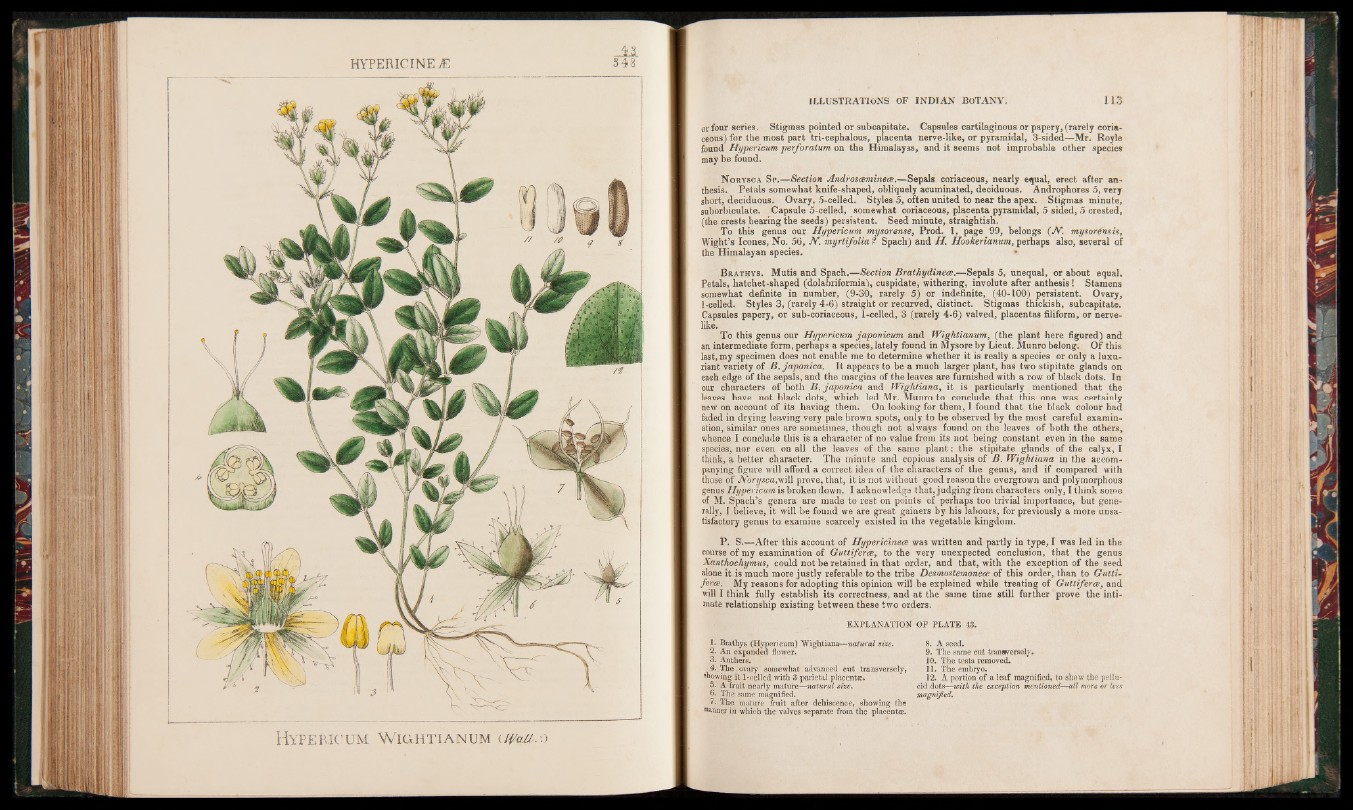
HYPERICINEÆ
Hypericum Wightianum WmmM
or four series. Stigmas pointed or subcapitate. Capsules cartilaginous or papery, (rarely coriaceous)
for the most part tri-cephalous, placenta nerve-like, or pyramidal, 3-sided—Mr. Royle
found Hypericum perforatum on the Himalayas, and it seems not improbable other species
may be found.
Norysca Sp.—Section Androsceminece.—Sepals coriaceous, nearly equal, erect after an-
thesis. Petals somewhat knife-shaped, obliquely acuminated, deciduous. Androphores 5, very
short, deciduous. Ovary, 5-celled. Styles 5, often united to near the apex. Stigmas minute,
suborbiculate. Capsule 5-celled, somewhat coriaceous, placenta pyramidal, 5 sided, 5 crested,
(the crests bearing the seeds) persistent. Seed minute, straightish.
To this genus our Hypericum mysorense, Prod. 1, page 99, belongs (A*, mysorensis,
Wight’s leones, No. 56, N . myrtifolia ? Spach) and H. Hookerianum, perhaps also, several of
the Himalayan species. *
B ra thy s . Mutis and Spach.—Section Brathydinece.—-Sepals 5, unequal, or about equal.
Petals, hatchet-shaped (dolabriformia), cuspidate, withering, involute after an thesis! Stamens
somewhat definite in number, (9-30, rarely 5) or indefinite, (40-100) persistent. Ovary,
1-celled. Styles 3, (rarely 4-6) straight or recurved, distinct. Stigmas thickish, subcapitate.
Capsules papery, or sub-coriaceous, 1-celled, 3 (rarely 4-6) valved, placentas filiform, or nerve-
like.
To this genus our Hypericum japonicum and Wightianum, (the plant here figured) and
an intermediate form, perhaps a species, lately found in Mysore by Lieut. Munro belong. Of this
last, my specimen does not enable me to determine whether it is really a species or only a luxuriant
variety of B. japonica. It appears to be a much larger plant, has two stipitate glands on
each edge of the sepals, and the margins of the leaves are furnished with a row of black dots. In
our characters of both B. japonica and Wightiana, it is particularly mentioned that the
leaves have not black dots, which led Mr. Munro to conclude that this one was certainly
new on account of its having them. On looking for them, I found that the black colour had
faded in drying leaving very pale brown spots, only to be observed by the most careful examination,
similar ones are sometimes, though not always found on the leaves of both the others,
whence I conclude this is a character of no value from its not being constant even in the same
species, nor even on all the leaves of the same plant: the stipitate glands of the calyx, I
think, a better character. The minute and copious analysis of B. Wightiana in the accompanying
figure will afford a correct idea of the characters of the genus, and if compared with
those of Norysca,vri\\ prove, that, it is not without good reason the overgrown and polymorphous
genus Hypericum is broken down. I acknowledge that, judging from characters only, I think some
of M. Spach’s genera are made to rest on points of perhaps too trivial importance, but generally,
I believe, it will be found we are great gainers by his labours, for previously a more unsatisfactory
genus to examine scarcely existed in the vegetable kingdom.
P. S.—After this account of Hypericinece was written and partly in type, I was led in the
course of my examination of Guttifcrce, to the very unexpected conclusion, that the genus
Xanthochymus, could not be retained in that order, and that, with the exception of the seed
alone it is much more justly referable to the tribe Desmostemonece of this order, than to Guttu
ferce. My reasons for adopting this opinion will be explained while treating of Guttiferce, and
will I think fully establish its correctness, and at the same time still further prove the intimate
relationship existing between these two orders.
EXPLANATION OF PLATE 43.
M Brathys (Hypericum) Wightiana—natural size.
2. An expanded flower.
3. Anthers.
A .T h e ovary somewhat advanced cut transversely,
showing it 1-celled with 3 parietal placenta.
5. A fruit nearly mature—natural 'size.
6- The same magnified.
*• The mature iruit after dehiscence, showing the
®anner in which the valves separate from the placentae.
8. A seed.
9. The same cut transversely.
10. The testa removed.
11. The embryo.
12. A portion of a leaf magnified, to show the pellucid
dots—with the exception mentioned—all more or less
magnified.